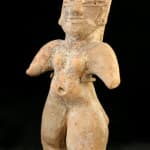Tlatilco Terracotta Sculpture of a Woman, 1200 BCE - 900 BCE
Terracotta
2.75 x 5.5
CK.0025
Further images
The ancient site of Tlantilco in the valley of Mexico came to light in 1936, during excavations carried out by brick workers digging for clay. While removing the clay in...
The ancient site of Tlantilco in the valley of Mexico came to light in 1936, during excavations carried out by brick workers digging for clay. While removing the clay in order to make bricks, these workmen discovered a large number of burials, in which were placed delicately modeled figurines, such as this remarkable example. Later excavations in the area, performed by archaeologists, revealed that these burials formed a portion of a very large village, Tlatilco, located west of the Great Lake on a small stream, and settled by about 1200 B.C. The figurines that appear in these ancient burials reveal that they are the most aesthetically satisfying in Ancient Mexico.
This terracotta figurine represents a standing woman with short, truncated arms and thick thighs, possibly symbolic of her fecundity. In contrast to the abstracted forms of the body, the facial features of the figure have been carefully delineated. Most prominently, she wears an elaborate headdress that covers her forehead.
This terracotta figurine represents a standing woman with short, truncated arms and thick thighs, possibly symbolic of her fecundity. In contrast to the abstracted forms of the body, the facial features of the figure have been carefully delineated. Most prominently, she wears an elaborate headdress that covers her forehead.





